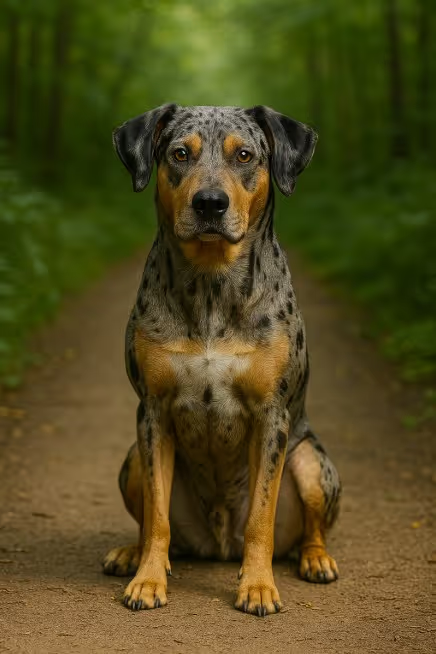The Catahoula Leopard Dog is a tough, intelligent American landrace bred in Louisiana for stock work, hog/bay hunting, and general farm duties. Known for its striking “leopard” (merle) coat and glass or odd-coloured eyes, the Catahoula is loyal, bold, and highly driven. Best suited to active, experienced owners who enjoy training, hiking, and giving their dog a real job. If you’re asking “Are Catahoulas good family dogs?”—yes, in structured homes. “Do Catahoulas shed?”—low to moderate. “Are Catahoulas hypoallergenic?”—no.

Originating in the American South (especially Louisiana), the Catahoula developed from Native American pariah dogs, European herders/curs, and hunting dogs. Farmers and hunters prized a gritty, multi-purpose stock and bay dog able to find, track, and hold game or control cattle in difficult terrain. The breed is Louisiana’s state dog and is maintained by registries such as NALC and UKC (AKC Foundation Stock Service in the U.S.). Today, Catahoulas remain versatile working dogs and dedicated companions when their needs are met.
A medium-to-large, athletic dog with strong bone and a weatherproof coat.
Low-maintenance coat with seasonal shed management.
A high-drive working athlete—plan for serious daily outlets.
Smart, independent, and powerful—clarity and consistency are essential.
Fuel the worker; keep lean for joint health and stamina.
Generally hardy, but merle genetics and working size require careful screening.
Seek transparency on working temperament, genetics, and health—or consider rescue.
Are Catahoula Leopard Dogs good family dogs?
Yes—for experienced owners who provide early socialization, structure, and daily exercise.
Are Catahoulas good apartment dogs?
Generally not ideal—possible only with 90–120 minutes of exercise, enrichment, and strong training.
Do Catahoula Leopard Dogs shed?
Low to moderate. Weekly brushing manages hair; expect seasonal increases.
Are Catahoulas hypoallergenic?
No. They are not hypoallergenic.
How much exercise does a Catahoula need?
Plan for 90–120 minutes daily plus brain work (tracking, nose games, obedience).
Can Catahoulas be off-leash?
Use caution—prey drive and independence are real. Proof recall on a long line and choose safe, enclosed areas.
What is the “leopard” pattern?
It’s merle—a mottled coat pattern. Responsible breeders avoid double-merle (MM) pairings due to hearing/eye risks.
Catahoula vs Australian Cattle Dog—what’s different?
Catahoulas are generally larger, multipurpose bay/stock dogs with merle and varied colours; ACDs are smaller heel-nipping herders with denser double coats.
What health tests should breeders do?
BAER hearing, CAER eyes, hip (± elbow) evaluations, and merle DNA pairing plans; discuss thyroid/orthopedic history.
Do Catahoulas bark a lot?
They can be vocal, especially as bay dogs. Teach “quiet” and provide scent/working outlets.